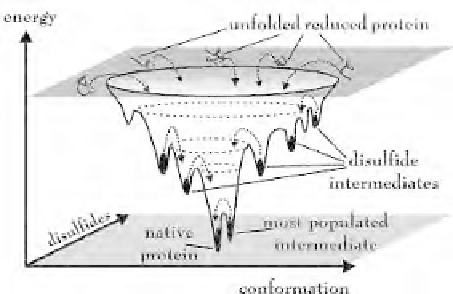Information Technology Reference
In-Depth Information
both non-native three-disulfide isomers as well as a predominant species with two native
disulfides (EGF-II).
3. Conclusions, scope and limitations
The graph representations described here provide a simple method to visualise folding
pathways as studied by experimental methods.
The picture emerging from these representations confirm that the folding pathways
of oxidative folding are contiguous routes that connect the fully reduced state to the native
state. If we try to reconcile this picture with the three-dimensional energy landscape of
oxidative folding, the energy of the protein will be a function of which disulfide bonds are
present and of the extent of conformational folding (Figure 7). The protein molecules will
have folded successfully when they reach the lowest energy point, which represents the
native species, both in terms of disulfides and conformation. The non-native disulfide
intermediates lie in the local energy minima, from where they have to be re-activated to
reach the native state. This picture suggests a qualitative explanation for the observation
that non-native disulfide intermediates can be the necessary steps of the folding pathways.
The cited case of pro-BPTI is an indirect proof for that. In the analysis of a small 3-
disulfide peptide, AAI we found that a disulfide intermediate with no native disulfide bonds
is in fact the most abundant species [30,31].
The current approach is limited by the fact that the 3D images of oxidative folding
pathways cannot be generated fully automatically. (A drawing application that uses the
Tulip package (www.tulip-software.org) is available from VA, vilagos@nucleus.szbk.u-
szeged.hu). A further plausible improvement would include colouring of the folding states
by quantitative properties and look for correlations between the coloured areas of the
network and the experimentally determined folding pathways.
Figure 7.
The energy landscape of oxidative protein folding [7]. The energy of the
protein is displayed as a function of which disulfide bonds are present and the extent
of conformational folding. The local minima represent non-native disulfide
intermediates, which are kinetic traps.

